Your complete guide to (myofascial) trigger points
Trigger points are those tender lumps in muscles that therapists find. This article covers what they are, what they do, and how they are... Read Article
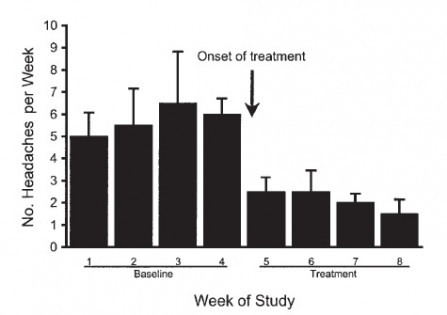
As the results from the clinical trial pictured show, massage or “pressure point” therapy has given excellent relief of headaches. In this guide we will show you how to do this at home, including:
Is your headache something that should be massaged?
We don’t want you doing massage or pressure points if you’ve really got a brain tumour or an aneurysm that’s about to burst, so please check out the guidelines below. Standard disclaimer: this article is for general information only. For specific advice please see a professional familiar with your needs.
Most articles on pressure points for headaches just give a small number of acupuncture based points. The problems with this are:
Giving a hand full of acupuncture points makes for great “click bait” headlines, but with only a fraction of the potential points and not knowing if they are actually involved any relief will usually be incomplete and short lived. In this guide we will show you all 9 muscles. It sounds a lot, but don’t worry though. In our video demonstration we will show you a simple routine where you can examine all in under a minute.
The points involved have been around for ever. When ancient civilisations found them they did not have the scientific knowledge we have today so they made their own systems using beliefs such as acupuncture meridians and “life forces”.
More recently scientists have identified the same points, calling them (myofascial) trigger points, or trigger points for short, and giving them proper scientific analysis. That’s made a huge difference.
The scientific "trigger point" approach has enabled us to properly identify the points involved and treat them effectively. In this guide we will use this approach.
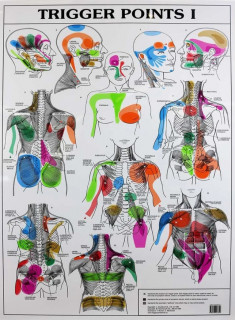
The scientists have found:
The way we find trigger points is to use the charts to see where to look, then examine looking for the tight muscle, tender lump and the shooting pain. In the next section we will show you the basic examination techniques, then show you specifically where to look in the section on individual muscles and points.
Please note that later in this article we have a video of Dr Graeme demonstrating all the procedures.
Note: these techniques are demonstrated in the video below.
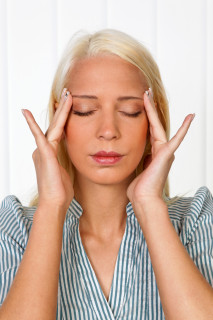
Systematically examine each muscle using the flats of your fingers. If an area of tenderness or tightness is found use one or two fingers to examine more deeply looking for a tender lump that shoots pain when pressed upon. Often this shooting pain will mimic your headaches, confirming the points are part of the problem.
Some muscles are very thin. These do not require deep pressure, and lumps can be very small and hard to find. Therefore, systematically examine the muscles with the pads of one or two fingers. Treat any area that feels tight or tender and maybe shoots pain when pressed upon.
The muscles containing headache producing points vary from thin muscles that overlay your skull through to the much thicker muscles on top of your shoulders. Because of this we will show you several effective techniques.
Please note that later in this article we have a video of Dr Graeme demonstrating all the procedures.
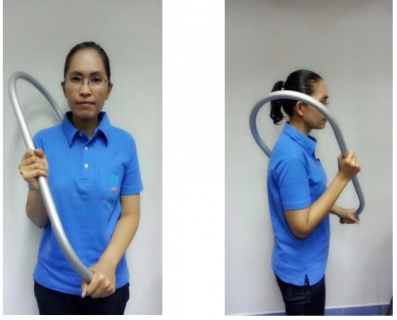
Therapists have found that if you apply pressure to these points they will gradually fade. Therapists often use prolonged painful pressure, but a trial has found that repeated moderate pressure is very effective (1). To do this all you need to do is apply moderate (not painful) pressure for 10 seconds, then repeat for a total of five times. In the video we show you three ways to apply this pressure.
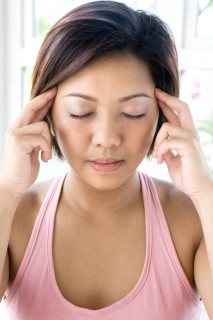
Many of the muscles of the head, neck and jaw are very thin or overlay sensitive structures. Because of this we will give you a special modified technique. This an amalgamation of the techniques used and found to be very effective in several clinical trials (2–6).
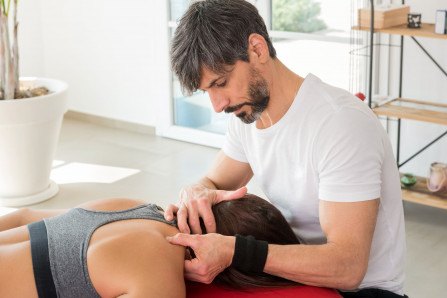
Some muscles are large enough and placed so they can be pinched, thus avoiding pressure on structures beneath the muscles. In these cases you can use a pinching action to both find the points and to apply the pressure. Use 10 seconds of pressure repeated five times as per the pressure for large muscles technique.
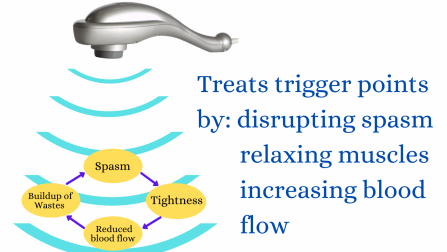
We have mentioned that scientific investigation has helped scientists understand these points and work out better ways to treat them. The best example is vibration massage. For this all you need to do is place the head of a vibration massager ( not a massage gun ) over the trigger point, and as this picture shows the vibrations penetrate, relaxing the muscle, increasing blood flow and helping flush out waste products. This method is the best by far for larger muscles, but is not suited for the very thin muscles and you need a proper massager . For more info please see our article How to treat trigger points .
You will need to keep repeating these treatments
As discussed in our article Why do trigger points keep coming back one or two treatments may provide temporary relief, but treatments will need to be continued to get rid of the problem. Again keeping in mind that this is general information to be discussed with a professional familiar with your own needs, you may need to repeat this daily until the tenderness has done, then less frequently but regularly to maintain your health.
The scientists have found that pressure points or trigger points in the following muscles can cause headaches (2–4,6–11). In the following section we will go over each muscle individually, showing where the common problems are and recommending the best treatment for each.
Upper trapezius
SCM (Sterncleidomastoid)
Sub occipital
Splenius capitus
Temporalis
Occipitalis
Masseter
Frontalis
This diagram shows the upper trapezius muscle with "x" marking the site of common points and the red being where they commonly refer pain to
The upper trapezius muscle is large and easy to pinch. Our recommended techniques are:
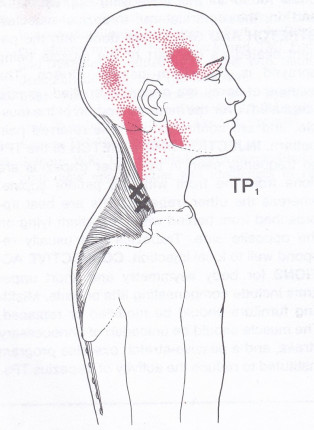
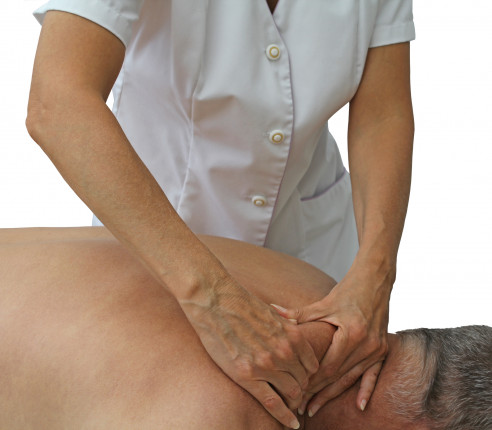
The diagram below shows the SCM muscle with "x" marking the the site of common points and the red being where they points commonly refer pain to.
The SCM overlies several sensitive structures therefore we only recommend you use pinching techniques. To help find the correct muscles and use the correct technique the second picture below shows the SCM bulging at the front.
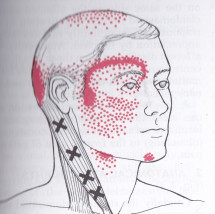
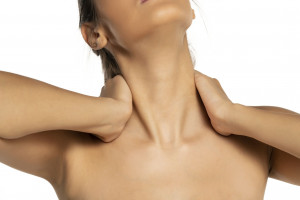
The diagram below shows the suboccipital muscles with "x" marking the the site of common points and the red being where they commonly refer pain to.
These muscles are deeper and at the base of your skull. I'd personally use a vibration massager for the quickest and best results, but for a non-professional a pressure technique using your thumb is probably easiest and best. The picture below shows someone else applying the pressure, but it is easy to use your own thumb. These muscles are often tight secondary to a joint problem so if the issues are difficult to clear or keep coming back please consult a professional such as a Chiropractor, Osteoptah or a Physiotherapist with special post graduate qualifications.
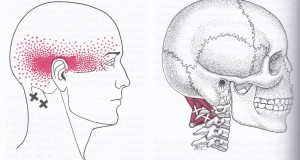
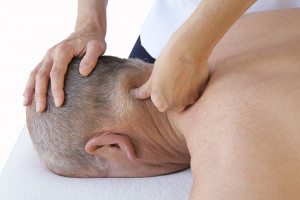
The picture below shows this muscle with the common trigger points and their pain referral pattern.
These are quite substantial muscles not overlying any highly sensitive structures, therefore vibration massage, self massage and pressure techniques all work well. If you use pressure limit it to light to moderate, and if you use vibration avoid vibrating your skull.
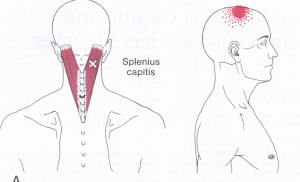
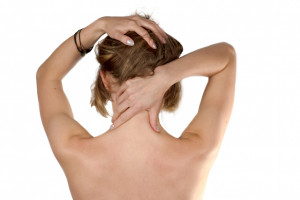
As shown below these four muscles sit over your skull and your jaw and commonly refer headache pain.
Because all these muscles are relatively thin and overly either your skull or your jaw only use the pressure techniques for smaller muscles (pictured above).
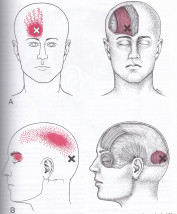
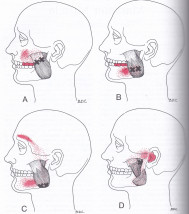
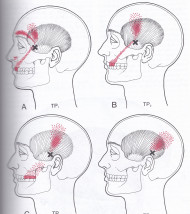
If you found this useful please check out our other self massage and trigger point therapy articles.
Massage And Trigger Point Therapy For Low Back Pain, With Self Help Options
Massage And Trigger Point Therapy For Calf Pain, With Self Help Options
Massage And Trigger Point Therapy For Shoulder Pain, With Self Help Options
Self Massage And Trigger Point Therapy For Tennis Elbow
Trigger Point Therapy For Fibromyalgia: Inc. Self Help Advice
Self Massage For High Blood Pressure
Self Massage For Anxiety
Trial |
What they did |
Results |
|---|---|---|
One session of trigger point therapy using simple pressure techniques |
Relief for about 52% of sufferers. Researches said that these simple techniques can be self applied |
|
Eight 30 minute sessions of massage and trigger point therapy over four weeks |
Excellent reduction in frequency of headaches |
|
Eight sessions of acupressure over one month. |
Significant reduction in headaches, including at six moth follow up. The acupuncture points identified by their meridian and number. These largely coincided with the sites of common trigger points. |
|
Trigger point therapy twice a week for an average of 6.5 sessions |
Headache frequency reduced 67.7%, intensity by 74.3%, and duration by 77.3%. No side effects were noted. |
|
Self trigger point therapy three times a day for four weeks. |
Intensity, frequency and duration of headaches and use of medications all reduced |
We don’t want you doing massage or pressure points if you’ve really got a brain tumour or an aneurysm that’s about to burst. Because of that we’ll give you some general information here, but for specific advice you’ll need to ask a professional familiar with your own needs.
There are two main types of headache: primary and secondary.
This are the main main type of headaches. They’re caused by pain from structures around your head and neck, typically the muscles of your head, neck and shoulders, or the joints of your upper spine. They’re often called “tension” or “cervicogenic” headaches, but also include migraines. These are usually excellent candidates for massage or “pressure point therapy”.
Secondary headaches are caused by something else, such as tumours, aneurysms or a disease. These need care other than massage or pressure point therapy.
This is for general information only and not a substitute for a professional diagnosis.
We are continually adding more information on research and uses. Subscribe below to have us email them to you "hot off the press".

Several years ago Dr Graeme, a Chiropractor practicing in Victoria, Australia was looking for a serious hand held massager his patients could use at home to get the extra quality massage they needed. The ones he found in the shops and on-line for home use looked nice but were not serious, and... read more
Trigger points are those tender lumps in muscles that therapists find. This article covers what they are, what they do, and how they are... Read Article
Although there have been many pressure points, reflex points and acupressure points reported to help reduce anxiety the results of many... Read Article
Massage or “pressure point” therapy has given excellent relief of headaches in clinical trials. In this article we will show you how to... Read Article
Clinical trials have shown that a variety of regular short duration remedial type massages improve the quality of sleep. These ranged... Read Article
Most professional athletes and sports clubs make heavy use of massage type treatments. The ability to do self massage using a hand held... Read Article
Do not refresh or leave this page until loading complete.